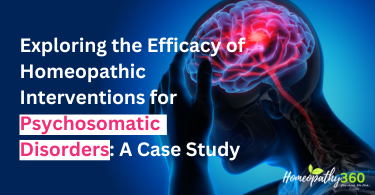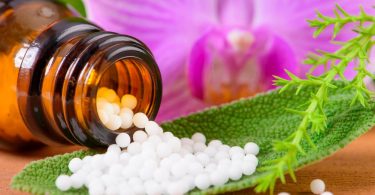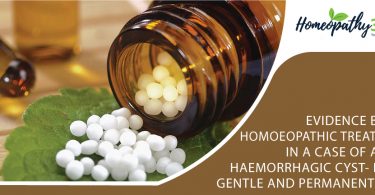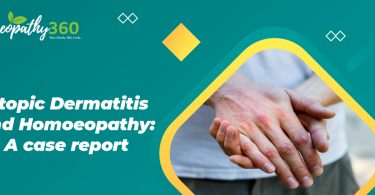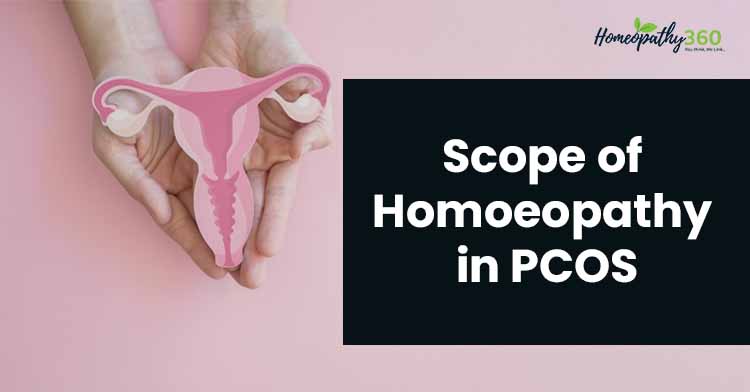
Abstract
PCOS is the most common endocrine disorder in females of reproductive age. The disease is mainly hyperandrogenic. It usually affects women between the ages of 18 & 44. Multiple morbidities are associated with PCOS including amenorrhoea, hirsutism, obesity, enlarged polycystic ovaries & infertility. PCOS may lead to serious consequences, including increased risk for the development of endometrial hyperplasia.
Case Summary: This case was treated with individualised homoeopathic medicine at the OPD of RBTS Government Homoeopathic Medical College & Hospital, Muzaffarpur, Bihar. A 25 year old girl presented with complaints of irregular menses and amenorrhoea for 1 and ½ months with pain in right iliac region always. Homoeopathic medicine Lycopodium was given to the patient on the basis of individualistic approach. The patient improved in her presenting complaints as well as there was change in diagnostic parameters. USG declared no obvious abnormality after homoeopathic treatment. This case report suggests that a correctly chosen homoeopathic medicine can be beneficial in the treatment of PCOS.
Keywords: Homoeopathy, Lycopodium, Polycystic Ovarian syndrome, Hyperandrogenism.
Abbreviations: PCOS – polycystic ovarian syndrome, OPD – outpatient department, USG – ultrasonography
Introduction
PCOS is also termed as POD (polycystic ovarian disorder). This is a heterogenous disorder and is marked by excessive androgen production by the ovaries mainly1. PCOS gets its term due to the formation of clusters of small, pearl-size cysts in ovaries2. These cysts are fluid filled follicles containing eggs and due to hormonal imbalance have not been released. PCOS is a multifactorial condition and is a combination of genetic and environmental factors. Lack of awareness, gestational environment and lifestyle changes are the major factors leading to this phenomenon. Environmental factors such as physical exercise, lifestyle and food may vary worldwide that results in genetic variance and imbalance of metabolic and reproductive pathways, which develop PCOS conditions and related complications3. Dysregulation of the CYP 11a gene, insulin receptor gene on chromosome 19p13.2 are also involved1. This is portrayed by increasing weight gain, irregular menstruation in the form of oligomenorrhoea, amenorrhoea, dysfunctional uterine bleeding and infertility. hirsutism and acne are the important features.
PCOS affects teenage girls and young women most commonly, nowadays it has become a common health problem2. Women who have PCOS are at risk for cardiovascular disease, diabetes and pre-diabetes, endometrial cancer, heart attack and hypertension2.
Two most common types of cysts are:
- Follicle cysts- In a normal menstrual cycle, an ovary releases an egg each month & grows inside a tiny sac called a follicle. When the egg matures, the follicle breaks open to release the egg usually. follicle cysts form when the follicle (tiny sac) doesn’t break open to release the egg. This results in the follicle to continue growing into a cyst.
- Corpus luteum cysts- once the follicle breaks open & releases the egg, the empty follicle sac shrinks into a mass of cells called corpus luteum. Formation of corpus luteum cyst occurs if the sac doesn’t shrink instead, the sac reseals itself after the egg is released, filling up fluid inside. Most corpus luteum cysts go away after a few weeks. They may cause bleeding and twisting of the ovary which may cause pain.
After detailed case taking on a standard case taking proforma, the totality of symptoms was built for the patient based on mental generals, physical generals, constitution, miasmatic background, family history, previous medical history etc. as per the homoeopathic principles.
Causes
The cause of PCOS is unknown but studies suggest a strong genetic component that is affected by gestational environment, lifestyle or environmental factors2. Abnormal function of the hypothalamic-pituitary-ovarian axis can result in PCOS. However, there are certain factors that cause it. They are:
- Genetic makeup
- Obesity
- Excess androgen
- Insulin resistance
Symptoms
Irregular menstruation– Most common signs of PCOS is irregular menstruation. Due to high amount of male hormones, the body prevents ovulation.
Heavy bleeding– Since the periods are irregular, uterine walls build up more. This leads to heavy bleeding.
Acne– Due to higher amounts of male hormone, the skin secrets more oil causing more acne.
Hair growth– Most women, who suffer from PCOS, have hair growth on their face, back, stomach and chest. The condition is known as hirsutism.
Weight gain– Most women who suffer from PCOS are obese or overweight.
Crown baldness– Most women with PCOS suffer from male pattern baldness and hair becomes thin on the crown.
Headache– headaches are triggered by hormonal imbalance.
Skin darkening– Women with PCOS experience darkening of skin in the groin, axilla and neck region. This condition is known as acanthosis nigricans1.
Complications
- Infertility- PCOS causes infertility as it reduces or may be completely absent the ovulation in the body.
- Diabetes- PCOS causes insulin resistance in the body and results in diabetes.
- Heart disease- PCOS increases blood pressure in the body leading to heart problems.
- Endometrial cancer- since in PCOS there is delayed ovulation, so thickening of the endometrium, the inner lining of the uterus. This increases the chance of getting endometrial cancer.
- Depression– women with PCOS undergo depression due to hormonal imbalance in the Body.
A CASE REPORT
Case history
A 25 years old, Hindu, girl reported in the obstetrics/gynaecology outpatient department of RBTS Government Homoeopathic Medical College and Hospital, Muzaffarpur, Bihar on 07/09/2022 with a complaint of amenorrhoea for 1 and ½ months and pain in right iliac region extend to left with history of irregular menses, mainly delayed menses. bleeding during menses clotted and menses is painful. The Patient was diagnosed with PCOD. She had taken allopathic treatment under a gynaecologist for 5 years. She got advice to take MALA D (contraceptive pills) for regular menstruation.
Mental general
The patient was very well behaved. She had fear of failure in examination. She always wanted company. She was miserly in her expenses. Her ambition was to make a lot of money. She is afraid of becoming poor.
Physical general
Her appetite was good and she always preferred warm food. She had the desire for spicy things with moderate thirst. Sleep was usually adequate, refreshing with non-specific sleep posture and dreams. She felt a heat sensation in palm. She also complained of pain in the right iliac region extending to the left. Menstrual cycle was irregular with dark clotted bleeding, and unbearable pain during menses.
Diagnostic assessment
As per the Rotterdam criteria, this is based upon the presence of any two of the following three criteria-
- Oligo and/or anovulation.
- Hyperandrogenism
- Polycystic ovaries.
AMH (anti-Mullerian hormone) is also a hormonal indicator and is important for maturation and development of ovarian follicles. Over secretion of AMH impedes follicular development which leads to ovarian malfunction3.
Investigations such as ultrasonography (whole abdomen) were carried out. Post-treatment outcome corroborated with follow-up investigation with significant changes. USG revealed no obvious abnormality after 3 months of continuous homoeopathic treatment with improvement in PCOD.
Analysis and evaluation of the symptoms with miasmatic analysis5:
| S. no. | Symptoms | Analysis | Evaluation | Miasmatic Analysis |
| 1. | Desire for company | Mental general | +++ | Psora |
| 2. | Cowardice | Mental general | ++ | Psora |
| 3. | Fear of failure in examination | Mental general | ++ | Psora |
| 4. | Fear of poverty | Mental general | + | Psora |
| 5. | Thirst for small quantity of water. | Physical general | +++ | Psora |
| 6. | Pain in right iliac region extending to left. | Particular | +++ | Psora |
| 7. | Menses with dark bleeding | Particular | + | Sycotic |
| 8. | Pain during menses aggravate | Particular | ++ | Sycotic |
| 9. | Tumour in ovary form cysts | Particular | +++ | Sycotic |
| 10 | Desire for spices food | Physical general | + | Psora |
Totality of symptoms
- Desire for company
- Cowardice
- Fear of failure in examinations.
- Fear of poverty.
- Thirst for small quantity of water
- Pain in right iliac region extending to left
- Menses with dark bleeding.
- Pain during menses aggravates.
- Tumour in ovary form cysts.
- Desire for spicy things
| S.no. | Symptoms | Rubrics |
| 1. | Desire for company | Company, desire for |
| 2. | Cowardice | Cowardice |
| 3. | Fear of failure in examination | Fear, failure of, in examination |
| 4. | Fear of poverty | Fear, poverty, of |
| 5. | Thirst for small quantity of water | Thirst, small quantities, for |
| 6. | Pain in right iliac region extending to left | Pain, right, extending to, left |
| 7. | Menses with dark bleeding | Menses, dark |
| 8. | Pain during menses aggravate | Pain -menses- during – agg. |
| 9. | Tumour in ovary form cysts | Tumour’s, ovaries, cysts |
| 10. | Desire for spicy things | Food and drinks-spices-desire |
REPERTORISATION SHEET:4
Figure 1. Repertorisation from synthesis repertory using Opus Radar Software4.
REPERTORIAL ANALYSIS
Lycopodium – 10/18
Arsenic – 9/14
Pulsatilla – 8/14
Sulphur – 8/12
REPERTORIAL SELECTION
As Lycopodium covers maximum numbers of rubrics and got highest marks. After consulting with Materia-Medica, Lycopodium was chosen for prescription.
THERAPEUTIC INTERVENTION
After detailed case taking on a standard case taking proforma, the totality of symptoms was built for patient based on mental generals, physical generals, constitution, miasmatic background, family history etc. as per the homoeopathic principles.
After repertorisation, the top medicines were Lycopodium, Arsenic, Pulsatilla, sulphur, phosphorus, Calcarea, Lachesis, Nux vomica, sepia. After carefully analysing the mental and physical generals of patient, considering the repertorial result and referring back to homoeopathic MM, a similimum was prescribed. Individualised homoeopathic treatment was started with two doses of Lycopodium 200 followed by placebo following the law of minimum dose.
PRESCRIPTION
Lycopodium 200/2 doses were given on the first visit in an empty stomach early in the morning.
Follow – up sheet
| Date of visit | Change in symptoms | Prescription |
| 19/09/2022 | Pain in right iliac region relieved much | Placebo for 3 days |
| 11/10/2022 | No pain in right iliac region and menstrual cycle recurred with normal bleeding and with slight pain. | Placebo for 3 days |
| 21/10/2022 | No pain in right iliac region and menses with normal bleeding and no pain during menses. | Placebo for 3 days |
| 12/11/2022 | No pain and regular menstrual cycle. | Placebo for 3 days |
| 28/12/2022 | No pain and normal regular menstrual cycle without pain. | Placebo for 3 days |
| 06/03/2023 | No pain and normal regular menstrual cycle without any problem. | Placebo for 3 days |
Comparison of USG report
Before Treatment:
- USG report shows B/L ovarian PCOD.
After treatment:
- Normal USG study.
- Both ovaries normal in shape and size.
CONCLUSION
Homoeopathy is a specialised system of medicine. It treats the patient as a whole and not just symptoms. Homoeopathic treatment is based on individualisation, acting best to cure the disease without harming other systems of the body. Post – treatment USG report is documentary evidence. This case shows a positive role of homoeopathy in treating PCOS.
REFERENCE
1.Dutta D C. Textbook of gynecology. # 7th edition. New delhi: jaypee brothers medical publishers (p) ltd;2016.
2.Rathpadmalaya. Management of PCOS through Homoeopathy.ijrh.20210825;12(2):01.
3.Raizada sonia. Homoeopathic management of polycystic ovarian syndrome. ijrh. 20220927;16(3):3.
4.Radar opus software (synthesis 9.0)
5.Sarkar BK. organon of medicine: Birla publications pvt. Ltd;2005-2006.


